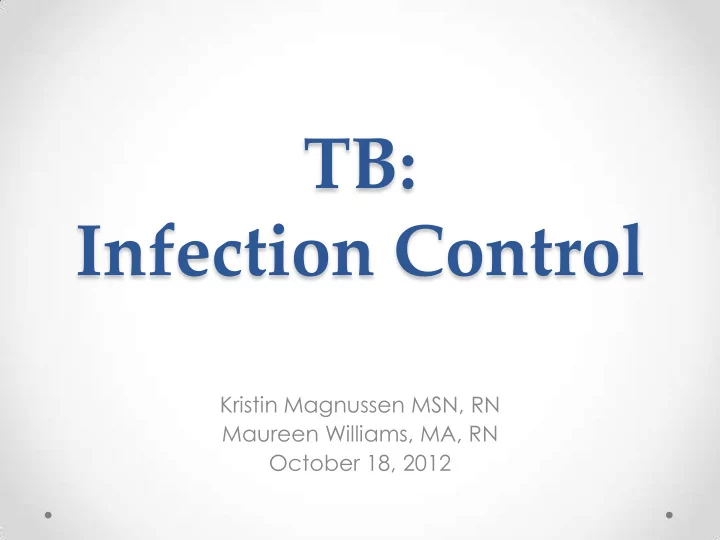

TB: Infection Control Kristin Magnussen MSN, RN Maureen Williams, MA, RN October 18, 2012
High Risk Workplaces • Health care facilities • Correctional institutions • Long term care facilities • Homeless shelters • Drug treatment centers 2011
Regulations • OSHA • CMS • State of CT Public Health Code → reporting → role of TB control & LHD • Facility P&P
Administrative Controls • Assign responsibility for TB Infection Control • Develop and update TB Infection Control Plan → Plans if accept TB patients → Plans if do not accept TB patients
Administrative Controls cont. • How to recognize TB promptly and what to do
Administrative Controls cont. • Know risk factors for developing TB disease → HIV strongest known risk factor → Children < 5 years of age → Persons on immunosuppressive therapy → Persons with silicosis, IDDM, ESRD, leukemia, lymphoma, or CA of head, neck of lung → Persons who have had gastrectomy or jejunoileal/ gastric by-pass → Persons weigh less than 90% of IBW → Substance abuse
Administrative Controls cont. • Annual risk assessment
Administrative Controls cont. • Test and evaluate HCWs for TB TB Screening Classification: HCWs Low risk • → 2 step TST on hire → annual testing not needed unless exposure occurs → + TST: CXR recommended Medium risk • → 2 step TST on hire → annual testing if negative; symptom survey if history of positive TST → + TST: CXR recommended if new positive, then annual symptom survey; RX Potential ongoing transmission • → testing every 6-8 weeks until lapses in infection control corrected and ongoing transmission not apparent → temporary; at most a year IGRA : if history of + TST/BCG •
Conversions • Previous – TST increasing 10mm or > within 2 years • Contacts: TST previously <5mm now ≥ 5mm • Do not count indeterminate QFT-G • Presumptive evidence of LTBI
Administrative Controls cont. • Implement effective work practices for managing TB patients • Timely availability of lab testing & reporting • Educate HCWs about TB infection control → where to get a copy of the plan & employer/employee roles → groups at risk for occupational TB → modes of transmission & symptoms of TB → TB screening and treatment for LTBI → MDR TB → procedure for isolating pts. with suspected / known infectious TB → administrative, engineering and PPE; reuse & disposal of respirators
Administrative Controls cont. • Ensure proper cleaning of equipment • Use signage for respiratory etiquette & hygiene • Quality Improvement
Engineering Controls ISOLATION • Facilities with AII Rooms → Control source of infection → Dilute and remove contaminated air → Control airflow (clean air to less clean air) → Signage → Supplies → Education of pt/visitors
Engineering Controls cont. • Home Isolation → CT standard of care → ventilation → visitors • TB Control Laws → plan of care → Isolation/Quarantine
Respiratory Protection Controls • Implement effective respiratory program
Respiratory Protection Controls cont. Train HCWs in respiratory program • → program administrator → SOP for selection, use & care of respirators → medical screening for respirator → annual training of HCW on prevention, transmission & symptoms → selection of respirator approved by CDC/NIOSH → fit testing → inspection & maintenance of respirators → periodic evaluation of program Train patients in respiratory hygiene •
Management of Suspect/Confirmed Cases • Key to prevention/interruption of transmission of TB → high index of suspicion → rapid implementation of precautions • Triage → medical history/evaluation → consider TB with respiratory sx; cough > 3 weeks, wt. loss night sweats, hemoptysis, hoarseness, fever, fatigue → where are they from? → immunocompromised, especially HIV +
Management of Suspect/Confirmed Cases cont. • Airborne precautions: AII room (airborne infection isolation) • If no AII rooms: → provide surgical mask to patient/resident → place in private room; close door → transfer to hospital; alert ambulance to wear N -95 • Discontinue precautions → another diagnosis made → 3 consecutive negative AFB sputum smears collected in 8 – 24 hour intervals with at least1 early morning sputum
Infectiousness • More likely to be infectious if: → have TB of the lungs or larynx; cavity in lung → coughing or undergoing cough-inducing procedures → AFB on sputum smear → not receiving adequate treatment • Exposure time, proximity & concentration • Determining Infectious Period
When Not Infectious? • Conservative: hospitals/corrections → 3 consecutive – AFB smears 8-24 hrs apart and, → clinical improvement and, → minimum of 2 weeks of treatment • Less conservative : not used for susceptible contacts or congregate settings → min. of 2 weeks of treatment w/ known susceptibilities and, → clinical improvement and, → decrease in grade of smear positivity
Preventing Outbreaks • Know risk factors for progression of LTBI to Active TB • Appropriate treatment • Contact investigation • DOT
Summary
Recommend
More recommend